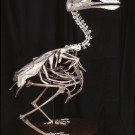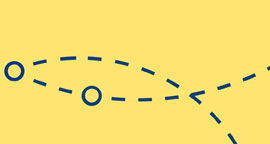Centre for Contemporary Culture at Palazzo Strozzi
Palazzo Strozzi
Christy Rupp

Christy Rupp‘s works reflect on the issues of mass production and the exploitation of animals in industrial processes. Her sculptures of extinct birds evoke the skeletons exhibited at museums of natural history, but they are actually made from countless bone fragments collected by the artist from the rubbish outside fast-food restaurants, the emblems of today’s materialistic consumerism.
Warning: A non-numeric value encountered in /var/www/vhosts/strozzina.org/httpdocs/admin/wp-content/plugins/lightbox-gallery/lightbox-gallery.php on line 443
- Exhibition view "American Dreamers", CCC Strozzina, Palazzo Strozzi, Firenze
Christy Rupp, Extinct Birds Previously Consumed by Humans, 2005-2008 Dodo, Moa, Great Auk, Ferro, ossa di pollo, materiali vari / Steel, chicken bones, mixed media Courtesy l’artista e / the artist and Frederieke Taylor Gallery, New York (foto Martino Margheri)
- Exhibition view "American Dreamers", CCC Strozzina, Palazzo Strozzi, Firenze
Christy Rupp, Extinct Birds Previously Consumed by Humans, 2005-2008 Dodo, Moa, Ferro, ossa di pollo, materiali vari / Steel, chicken bones, mixed media Courtesy l’artista e / the artist and Frederieke Taylor Gallery, New York (foto MArtino Margheri)
- Exhibition view "American Dreamers", CCC Strozzina, Palazzo Strozzi, Firenze
Christy Rupp, Varoius works, Courtesy l’artista e / the artist and Frederieke Taylor Gallery, New York (foto Martino Margheri)
- Exhibition view "American Dreamers", CCC Strozzina, Palazzo Strozzi, Firenze
Christy Rupp, Dim View, 2007-8 Collage in carta / Cut paper collage Brinkiness, 2007-8 Collage in carta / Cut paper collage No Way Home, 2007-8 Collage in carta / Cut paper collage Tutte le opere / All the works: Courtesy l’artista e / the artist and Frederieke Taylor Gallery, New York (foto Martino Margheri)
- Christy Rupp
Dim View, 2007-8 - Collage in carta / Cut paper collage - 40,6 x 50,8 cm - Courtesy l’artista e / the artist and Frederieke Taylor Gallery, New York
- Christy Rupp
Brinkiness, 2007-8 - Collage in carta / Cut paper collage - 40,6 x 50,8 cm - Courtesy l’artista e / the artist and Frederieke Taylor Gallery, New York
- Christy Rupp
No Way Home, 2007-8 - Collage in carta / Cut paper collage - 40,6 x 50,8 cm - Courtesy l’artista e / the artist and Frederieke Taylor Gallery, New York
- Christy Rupp
Dodo (83 x 40 x 68 cm) dalla serie / from the series Extinct Birds Previously Consumed by Humans, 2005-2008 - Ferro, ossa di pollo, materiali vari / Steel, chicken bones, mixed media - Courtesy l’artista e / the artist and Frederieke Taylor Gallery, New York
- Christy Rupp
Great Auk (76 x 43 x 55 cm) dalla serie / from the series Extinct Birds Previously Consumed by Humans, 2005-2008 - Ferro, ossa di pollo, materiali vari - Steel, chicken bones, mixed media - Courtesy l’artista e / the artist and Frederieke Taylor Gallery, New York
The main theme of Christy Rupp’s work is the reflection on the relationship between man and nature when nature becomes something used in a purely utilitarian way. For her collages, Rupp uses paper decorated with floral motifs reminiscent of Art Nouveau or of the Arts and Crafts movement of the late 19th century, that began as a reaction on the part of artists and thinkers who were critical of the mechanisation and mass production that had emerged in the early days of the Industrial Revolution.
In her series Extinct Birds Previously Consumed by Humans, Rupp addresses the incongruity between the fast-food industry with its mode of mass production and the beauty the artist recognizes in individual animals. To develop the series, Rupp spent several years gathering chicken and turkey bones she collected through friends, from fast-food joints and barbecues, and by placing advertisements in small town newspapers to gather large amounts of leftover bones. She then started to meticulously assemble these organic elements into life-size sculptures, building representations of extinct birds. Her series developed as the artist retrofitted a group of skeletal representations of Great Auks, Moas, and Dodos, all species of flightless endemic birds that became extinct when man invaded their native lands.
The careful, manual process with which Rupp assembles her animal structures is in strident contrast with the context in which she sources her bone material. The artist rearticulates the refuse of the fast-food society whose rationale of industrial productivity degrades every living creature to the role of an object for commercial use. Paradoxically, Rupp’s works evoke the aesthetics found in natural history museums, appropriating the likenesses of unique and precious objects worthy of preservation as part of our cultural heritage. Time is a crucial element in the work of this artist who juxtaposes an extremely slow and laborious manual processes to create her works to the lifetime of, say, a battery hen. Rupp introduces subtle metaphors that address compelling and very serious issues like the increasingly alienated and destructive relationship between man and all other living creatures.
Christy Rupp (1949, Rochester, NY, USA; lives and works in New York and Catskills) graduated in 1973 at the Colgate University and earned her MFA in 1977 at the Rinehart School of Sculpture, Maryland Institute College of Art. She is as much a research scientist as she is an artist. Her sculptures raise complicated issues about bio-diversity and genetic engineering, globalization and personal choice, and she has also developed projects with the Paleontology Department of the American Museum of Natural History. She often uses recycled material to create new animal and plants, reflecting on the employment of the natural sources and the necessity to safeguard animal and plant species. Her works have been exhibited at the Brooklyn Museum, the MoMA in New York, the National Gallery in Washington and the Burchfield-Penney Art Center in New York. She has also realized public commissioned works for Central Park in New York, the Municipal Art Society in Baltimore, the NYC Percent for Art Program and many others. Recent collective exhibitions include: (2011) A Show About Collab, Printed Matter, New York; Living Here, KTD Monastery, Woodstock, OR; Buffalo on the Bowery, Charles Bank Gallery, New York; Pop Patriotism, Carriage Trade, New York; Outer Space, Exit Art, New York; Dead or Alive, Museum of Arts and Design, New York.
« back to exhibition
| M | T | W | T | F | S | S |
|---|---|---|---|---|---|---|
| « Jun | ||||||
| 1 | 2 | 3 | 4 | 5 | 6 | |
| 7 | 8 | 9 | 10 | 11 | 12 | 13 |
| 14 | 15 | 16 | 17 | 18 | 19 | 20 |
| 21 | 22 | 23 | 24 | 25 | 26 | 27 |
| 28 | 29 | 30 | 31 | |||















